As much as I love my garden, there are some plants that make me want to throw in the trowel.
I don’t think there are any plants that are inherently bad. But there are plenty of plants that will become your worst nightmare if placed in the right environment. I could come up with a much longer list, but these are the first ten plants that come to mind that make my blood boil.
Some are worse than others, but for the vast majority, my problems could have been avoided with a little research before I brought the plant home or at least before I planted it. Funny how I used to tell people to do this as part of my job but you will notice by my list that I have a hard time following my own advice!
Garlic Chives (Allium tuberosum)— When I was first interested in herbs back in high school, I remember searching high and low for this plant and having to settle for seeds I ordered from a catalog. I nurtured my little seedlings and this fall-flowering, garlic and onion flavored herb was never a problem at my parent’s house.
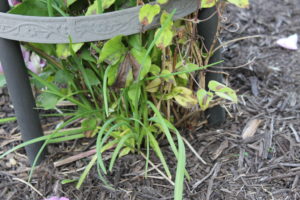
Garlic chives growing at the base of a Clematis.
Flash forward to my own house, where I eagerly planted a little herb garden in the perfect little sun-filled alcove near our patio. By this time it was easy to find garlic chive plants for sale. After the first year or two, we started finding a few stray garlic chives in nearby flower beds; it has gotten progressively worse.
We have beaten these plants back regularly but they still show up. This is probably because we just can’t get them all. The seedlings are small and thin like blades of grass and impossible to pull. They have to be dug out, or sprayed with glyphosate (Roundup®) individually if you have the time and patience. Why didn’t they cause the same problem in my parent’s garden? I’m sure it’s because they were planted on the edge of the vegetable garden which got tilled once a year, destroying any seedlings that might have emerged.
Variegated Artemesia (Artemesia vulgaris ‘Janlim’ a.k.a. ‘Oriental Limelight’)— I get excited when I finally have some time to work out in my garden, but when I see this plant I want to drop all my tools and go inside. Unfortunately, I brought this plant home on purpose from a community plant sale because I thought it was pretty. I love variegated foliage. Nobody, including myself, knew the identity at the time. I tell people all the time to not buy unidentified plants, but my “Ooooo pretty plants” reaction got the best of me.
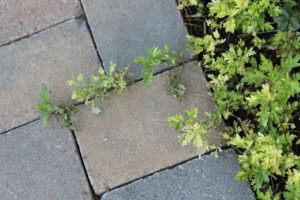
Variegated artemesia somehow growing in between bricks set in mortar
I so deeply regret planting this plant. Mint has a reputation of being aggressive in the garden, but this plant is like mint on steroids. It spreads via underground rhizomes, and has the unfortunate feature of growing back from any fragment of plant material left behind. I’ve sprayed it with glyphosate (Roundup®) and what survived came back with a vengeance. This plant would be a really good choice for a hillside or bare area that has boundaries so it can be contained. If you really want to use it in the garden you could plant it in a container; even so I would keep a close eye to make sure it doesn’t escape the container.
Pink Primrose (Oenothera speciosa)— This is another problem plant brought to my garden by my “Ooooo pretty plants” reaction. I first spotted this plant along roadsides in Arkansas when I was there for a conference in 2007 and I thought they were gorgeous.
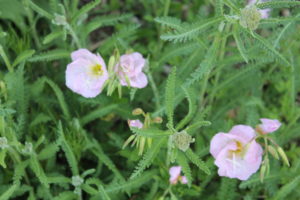
Pink primrose growing along with yarrow.
I was at a garden center after I returned home and happened to see the same plant with beautiful soft pink flowers for sale. Of course without thinking I bought it and planted it. Without researching it like I tell other people to do. If I had researched it I would have found it reseeds. A lot.
The plant I originally planted was a 3-4 inch pot. It took off like wildfire in my garden. Thankfully it is easy to pull, the plant itself is maybe 18 inches tall max with fine foliage that isn’t super noticeable. But that original pot has reseeded itself on 3 of 4 sides of my house! This is another plant that would be a great choice for a space where you want something to fill in an area.
Lemon Balm (Melissa officinalis)— This was another plant I looked everywhere for when I first discovered herbs back in high school. Like my first garlic chives, I started my first lemon balm plants from seed and carefully nurtured them along. Lemon balm is in the mint family, and like so many plants in this family, it is an aggressive grower. I did a pretty good job keeping those first plants in check until their second year when they flowered and went to seed. Lemon balm was coming up everywhere!
Unlike the garlic chives, lemon balm seeds didn’t sprout early in the season before tilling the garden. The plants go to seed in the middle of summer and the seeds start sprouting right away– instant problems. The plants are tough to pull, especially if you miss them when they first emerge. I have never planted lemon balm since.
Clustered Bellflower (Campanula glomerata a.k.a. “The Globerots” )— Years ago the Master Gardeners I worked with were labelling plants for their annual Garden Walk and a plant identification question came up– what were globerots? I had never heard of such a plant. Stumped, I went with a Master Gardener that was the Yoda of plant identification to see the plants in question. I will always remember his exclamation of “Campanula glomerata!”
It turned out that the crew helping to label plants didn’t recognize the plants but found a piece of an old plastic plant tag and from what they could decipher they decided on “globerots” for the plant name. This plant was recommended to me at a community plant sale as the perfect blue flower for my Illini garden. The “Oooo pretty plants” response took over. Again, I did no research and regretted it. The flowers were indeed gorgeous. But the plant spread like mad– both from the dreaded creeping rhizomes and possibly seeds as well. It took me 8 years ofpersistent pulling and repeat applications of Roundup® to completely eradicate this plant. We still refer to this plant as “globerots” because it sounds like an alien robot invasion. It definitely invaded our garden!
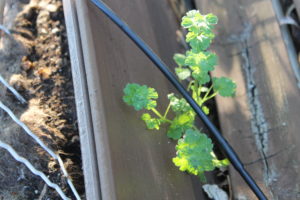
Henbit growing out of the side of one of our raised beds!
Creeping Charlie (Glechoma hederacea) & Henbit (Lamium amplexicaule)— You may have read my post about creeping Charlie being my dad’s most hated weed. A weed commonly confused with creeping Charlie is henbit, a weed that thrives in cool weather. Here in central Illinois, it is gorgeous in the early spring, carpeting fields in big wide swaths of bright purple flowers. This year it was particularly prolific since we had a mild winter and it kept growing much longer than usual. In reality if you have this weed it is tough to eradicate; its another one of those really persistent plants that will grow just about anywhere.
Poison Ivy (Toxicodendron radicans)— I’d only ever seen poison ivy along the edge of the woods not far from our house until about four years after we moved in. Up to that point, I had never had poison ivy in my whole life. That year, working in the garden doing my usual spring cleanup and spreading mulch, I developed a blistering rash. My husband took one look at and knew it was poison ivy. But from where? We went back to look where I had been working the past few days and found several poison ivy seedlings.
We kept looking and found seedlings wherever we had put new mulch. That year we had used a new source for garden mulch. There must have been bits of poison ivy shredded up with the bark and the bits of stem were regenerating poison ivy seedlings all over our garden. It took us a few years to eradicate the poison ivy, mostly by digging out the plants and discarding them in the trash. The chemical that causes the reaction to poison ivy, urushiol, is incredibly persistent. It can survive for years on dead foliage, garden tools and gloves and still cause a reaction if you touch it.
**Don’t ever burn poison ivy. I met a man that came into my office dragging an oxygen tank and he told me how he had spend weeks in the ICU after he breathed in smoke from burning poison ivy. He was sure he was safe, standing upwind, but the wind shifted.
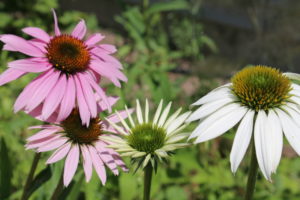
I planted an older white-flowered Echinacea cultivar ‘White Swan’ years ago. It is a prolific re-seeder. There are quite a few purple-flowered plants in the mix now along with white-flowered ones;the bees and butterflies love the blooms.
Coneflower (Echinacea novelty colors other than purple)— This is the only plant on my list because of its failure to grow rather than it’s prolific growth. I’m fascinated by new plant varieties. The more unusual the better. This is at least part of the reason I studied plant breeding in graduate school.
When retailers introduced the first coneflowers that weren’t purple or white (‘Art’s Pride’ a.k.a. ‘Orange Meadowbrite’ was the first one I planted), I bought every one I could get my hands on.
Plant breeders develop new Echinacea colors in multiple ways. Some are deliberate crosses of different species of Echinacea which produce offspring with a wide range of different traits. Some are naturally occurring mutations found and propagated.
The purple-flowered Echinacea purpurea grew really easily in my garden; I assumed the new cultivars would be just as hardy and easy to care for. I was so wrong. A lot of them didn’t survive well in my garden just for a single growing season. Those that did survive looked great for a season or two, then disappeared entirely, seemed to revert to purple or the original plant died and was replaced by a purple flowered seedling.
Turns out this is not an unusual thing. Many people report these new cultivars have issues. Some nurseries, like Blooming Nurseries in Cornelius, Oregon are testing new cultivars themselves to make better recommendations to their customers. This year I planted a ‘Sombrero® Hot Coral’ Coneflower that has had some favorable reviews. We’ll see how well it grows in my garden.
Bronze Fennel (Foeniculum vulgare ‘Purpureum’)— My husband gets the credit for first hating this plant in our house. I bought bronze fennel because it is a host plant for the Eastern black swallowtail butterfly. Plus its pretty feathery foliage is a nice contrast in our perennial garden.
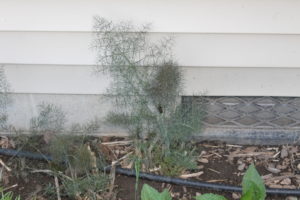
Bronze fennel seedlings
But once again, I neglected to research before I bought the plant. Fennel reseeds like crazy. Everywhere. I’ve been able to curtail the spread and my husband’s frustration by removing the flowers before they form seed heads. But there must be an enormous seed bank of fennel seed in my garden beds. I keep finding fennel seedlings all over the place! Good news is they pull easily when they are small.
Zebra Grass (Miscanthus sinensis ‘Zebrinus’) I love zebra grass, especially once the seed heads form. They are gorgeous swaying in the wind and add some variety to our winter landscape, The problem is you had better be happy about where you put it because like a lot of ornamental grasses it is extremely hard to move after the fact. It has extremely deep roots and you about need a backhoe to get it out.
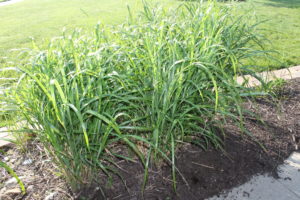
Zebra grass that will probably grow in front of our house for all eternity.
We planted two plants flanking a “dry creek bed” we constructed to handle a drainage issue near our house when we first moved in. We fixed the drainage issue so we no longer need that constructed area. My husband and I just look at that spot and sigh when we talk about changing it.
How to avoid creating your own worst landscaping nightmare:
- Research. Do your homework on new plants for your landscape.
- Be a little cautious at community plant sales. If there is an eight foot long table all containing one kind of plant, this may likely be a plant to avoid like the plague. Plants that grow in excess enough to fill a long table at a sale, are likely aggressive growers that will wreak havoc in your garden.
- If you find that you can’t resist bringing home unfamiliar plants, create a “quarantine” or “plant purgatory” somewhere in your yard. I know a few people who do this. *I* need to start doing this. I can’t rely on willpower when faced with a pretty plant! It gives an opportunity to see how a plant will grow before allowing it into the main garden. It’s much easier to kill off an aggressive plant in a bed by itself than when it has grown in and around the rest of your landscaping.
Are there plants in your garden that drive you nuts that didn’t appear on my list? Please share in the comments!
If you liked this post, please subscribe to Grounded and Growing today and receive your copy of “15 Tips to Become a '15 Minute Gardener'” so you can spend less time working ON your garden and more time enjoying being IN your garden.! It’s absolutely free. When you join the Grounded and Growing community, you’ll finally take the garden off your “To-Do” list and allow yourself time to enjoy your garden and savor the peace and serenity there. I tell subscribers about new posts as soon as I hit ‘publish’ and send weekly-ish updates on what’s going on in my garden– good, bad AND ugly.
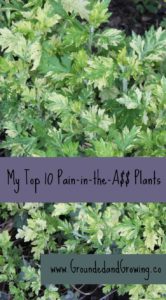
This reminds me of a story I once heard from a former grad student. He was at a local rummage sale where there was a woman selling little pots of Creeping Charlie. He asked her if she knew what she was selling, and her reply was, “Well, I don’t know its name, but it makes an excellent ground cover and has pretty, purple flowers!”
That’s so classic Margaret! I guess weeds are in the eye of the beholder.
I’ve been fighting Lily of the Valley for years!! I love it because of its smell but hate its aggressive root system!!! I think I have it all dug up and before I know it it’s back again!!!!
I love the scent too but I’ve been scared to plant it at my house. I’ve heard too many horror stories. My grandma used to call it “Lily of the Alley” she hated it so much. My mom has it in a bed where nothing else will grow and hasn’t had any problems.
Can u eat the fennel bulbs??? Pink primrose…mine died and so did yellow primrose. Great share on nightmare plants!!! Thank you, Jen!!!
The bronze fennel never seems to make a bulb. You can definitely eat the foliage though. Glad you enjoyed the article!
But now you have two helpers to pull all those nasty plants out of the garden:)
Yes if only they would stick to the nasty plants!!
A plant with which I have a love and hate relationship is liriope. It is a great plant to use as a border or to fill an area as a foot-high ground cover. It grows in shade and sun. It is pretty a green as it sways in the wind. The only care it needs is a very early spring trim, which can be done with a lawn mower if the area permits.
But it creeps with underground root growth and multiplies fast. A couple of patches stay in check because we mow around them. But the plants that line my sidewalks near flower beds keep creeping into the flower beds. I dig. I pull. I hoe. I have to spend lots of time controlling it.
My advise: Use it to cover an area that you can mow around.
Thanks Ruth Ann! I’ve heard liriope can be a bully, but at my house it petered out. I think part of that reason was I tried the variegated version. Variegated plants are often times wimpier than their solid green relatives!